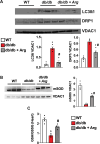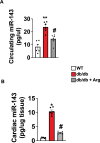L-Arginine supplementation as mitochondrial therapy in diabetic cardiomyopathy
- PMID: 39707340
- PMCID: PMC11662564
- DOI: 10.1186/s12933-024-02490-x
L-Arginine supplementation as mitochondrial therapy in diabetic cardiomyopathy
Abstract
In patients with type II diabetes, the development of diabetic cardiomyopathy (DC) is associated with a high risk of mortality. Left ventricular hypertrophy, diastolic dysfunction, and exercise intolerance are the first signs of DC. The underlying mechanisms are not fully elucidated, and there is an urgent need for specific biomarkers and molecular targets for early diagnosis and treatment. Mitochondrial alterations play a key role in the development of DC, and microRNAs regulating mitochondrial function are emerging as potential biomarkers of metabolic stress in DC. L-Arginine (Arg) supplementation has been shown to be an effective strategy for improving mitochondrial function and energetics, with a significant impact on physical performance. The aim of the current study was to evaluate the effects of Arg supplementation on cardiac mitochondrial function, DC development, and relative phenotypes including exercise intolerance. We used db/db mice as a model of type II diabetes, chronically treated with Arg (1 mg/kg/day) for 12 weeks. Arg-treated db/db mice showed preserved diastolic function and left ventricular morphology compared with untreated diabetic mice. Arg supplementation also improved exercise tolerance and the propensity to physical activity. Mitochondrial respiration was significantly increased in cardiomyocytes isolated from treated db/db mice, as well as in diabetic cardiomyocytes treated with Arg in vitro. The improvement of cardiac mitochondrial function in db/db + Arg mice was associated with an increase in PGC-1-alpha levels, mitochondrial biogenesis, recycling, and antioxidant capacity. Arg treatment prevented the accumulation of circulating and cardiac miR-143 in db/db mice, which is an index of metabolic stress and activation of mitochondrial damage mechanisms. In conclusion, Arg supplementation is effective in preventing the development of DC, preserving diastolic function and exercise tolerance by improving mitochondrial fitness and homeostasis. Additionally, miR-143 could potentially be employed to monitor cardiac metabolic stress and the effects of Arg treatment in diabetes.
© 2024. The Author(s).
Conflict of interest statement
Declarations. Competing interests: Gaetano Santulli declares that he is Associate Editor of Cardiovascular Diabetology and that the article was assigned to another Editor to assume responsibility for overseeing peer review. This submissions was subject to the exact same review process as any other manuscript submitted to the journal. Licenses: Figure 1 was created in BioRender. License was granted to Iaccarino, G. (2024- BioRender.com/c38b746).
Figures







References
-
- Flarsheim CE, Grupp IL, Matlib MA. Mitochondrial dysfunction accompanies diastolic dysfunction in diabetic rat heart. Am J Physiol. 1996;271(1 Pt 2):H192–202. - PubMed
Publication types
MeSH terms
Substances
Grants and funding
- (E63C22002050006)./PNRR NGUE- PE8 Age.it
- Next Generation EU, National Recovery and Resilience Plan, Investment PE8-Project Age-It: "Ageing Well in an Ageing Society"./Ministero dell'Istruzione, dell'Università e della Ricerca
- PON "REACT-E U" IV.4 action 2014-2020/European Commission
- R01 HL164772/HL/NHLBI NIH HHS/United States
- R01 HL159062/HL/NHLBI NIH HHS/United States
- R01 HL146691/HL/NHLBI NIH HHS/United States
- T32 HL144456/HL/NHLBI NIH HHS/United States
- T32 HL172255/HL/NHLBI NIH HHS/United States
- R01 DK123259/DK/NIDDK NIH HHS/United States
- R01 DK033823/DK/NIDDK NIH HHS/United States
- UL1 TR002556/TR/NCATS NIH HHS/United States
- UM1 TR004400/TR/NCATS NIH HHS/United States
LinkOut - more resources
Full Text Sources
Medical
Miscellaneous

